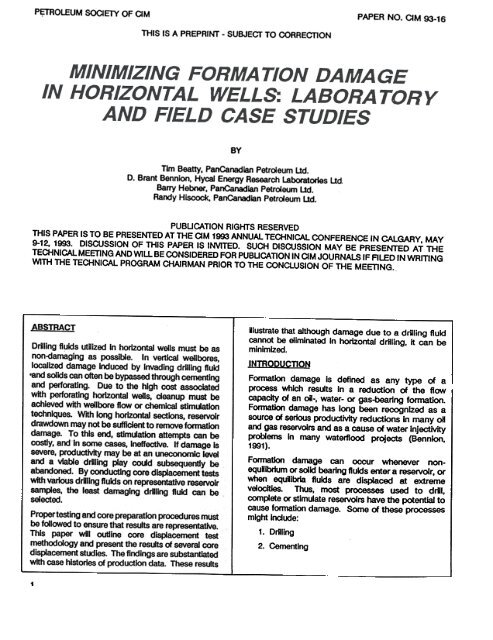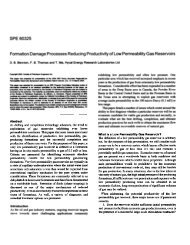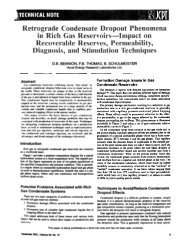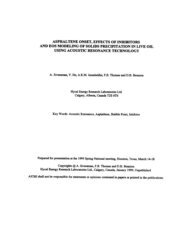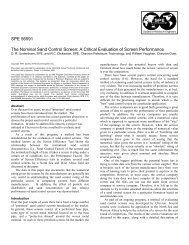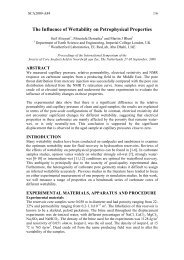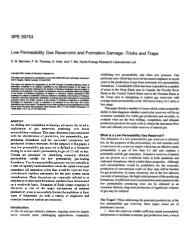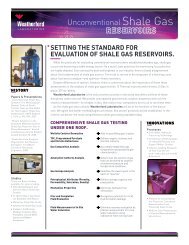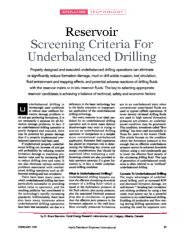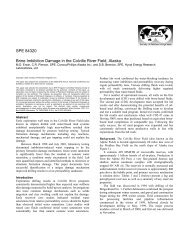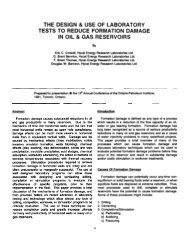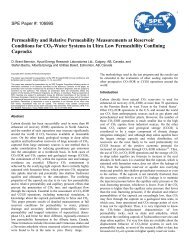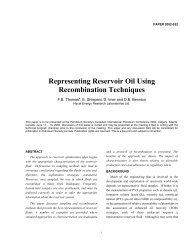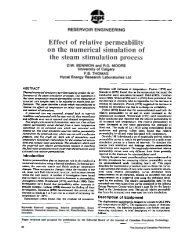Minimizing Formation Damage in Horizontal Wells - Weatherford ...
Minimizing Formation Damage in Horizontal Wells - Weatherford ...
Minimizing Formation Damage in Horizontal Wells - Weatherford ...
You also want an ePaper? Increase the reach of your titles
YUMPU automatically turns print PDFs into web optimized ePapers that Google loves.
P~OLEUM SOOETY OF ClM PAPER NO. aM 93-16THIS IS A PREPRINT - SUBJECT TO CORRECTIONBYTim Beatty, PanCanadlan Petroleum Ud.D. Brant Bennion, Hycai Energy Research laboratories Ud.Barry Hebner, PanCanadlan Petroleum Ud.Randy Hiscock, PanCanadlan Petroleum Ud.PUBUCATION RIGHTS RESERVEDTHIS PAPER IS TO BE PRESENTED AT THE ClM 1993 ANNUAL TECHNICAL CONFERENCE IN CALGARY, MAY9-12,1993. DISCUSSION OF THIS PAPER IS INVITED. SUCH DISCUSSION MAY BE PRESENTED AT THETECHNICAL MEETING AND WILL BE CONSIDERED FOR PUBUCATION IN ClM JOURNAlS IF ALED IN WRmNGWITH THE TECHNICAL PROGRAM CHAIRMAN PRIOR TO THE CONCLUSION OF THE MEETING..ABSTRACTDrill<strong>in</strong>g fluids utUlzed In horizontal w~ls must be asnon-oamaglng as possl~e. In vertical wellbores,localized damage Induced by Invad<strong>in</strong>g drill<strong>in</strong>g fluid-and solids can often be bypassed through cement<strong>in</strong>gand perforat<strong>in</strong>g.. Due to the high cost associatedwith perforat<strong>in</strong>g horizontal wells, cleanup must beachieved with w~lbore flow or chemical stimUationtechniques.. With long horizontal sections, reservoirdrawdown may not be sufficient to remove formationdamage.. To this end, stlmldatlon attempts can becostfy, and <strong>in</strong> some cases, Ineffective.. if damage Issevere, productMty may be at an uneconomic leveland a vIa~e drUl<strong>in</strong>g play could subsequently beabandoned. By corKfuct<strong>in</strong>g core displacement testswith variOus drill<strong>in</strong>g fluids on representative reservoirsamples, the least damag<strong>in</strong>g dril<strong>in</strong>g fluid can beselected..Proper test<strong>in</strong>g and core preparation procedures mustbe falowed to ensure that results are representative..This paper wUl outl<strong>in</strong>e core displacement testmethodaogy and present the resUts of several coredisplacement studies. The f<strong>in</strong>d<strong>in</strong>gs are substantiatedwith case histories of productJon data. These resutsKlustrate that although damage due to a drill<strong>in</strong>g fluidcannot be elim<strong>in</strong>ated In horizontal drill<strong>in</strong>g, It can bem<strong>in</strong>imized.INTRODUCTlO~<strong>Formation</strong> damage Is def<strong>in</strong>ed as any type of aprocess which results In a reduction of the flowcapacity of an oil-, water- or gas-bear<strong>in</strong>g formation.<strong>Formation</strong> damage has long been recognized as asource of serious productMty reductions In many oiland gas reservoirs and as a cause of water InJectivityproblems In many waterflood projects (Bennion,1991).<strong>Formation</strong> damage can occur whenever nonequRlbriumor solid bear<strong>in</strong>g fluids enter a reservoir, orwhen equRlbria fluids are displaced at extremevelocities. Thus, most processes used to dril,complete or stimulate reservoirs have the potential tocause formation damage. Some of these processesmight Indude:1. Drll<strong>in</strong>g2. Cement<strong>in</strong>g1
CASE #1Geoloaical DescriRtionThe Countess Upper Mannville 8RR8 Poa Is locatedIn Sec.35. TO'Nnshlp 18. Range 16 W4M In theprov<strong>in</strong>ce cX Alberta. The poQ has seven verticalproduc<strong>in</strong>g oR wells and one horizontal on well 12D-35-18-16 W4M (see FIgure 2). The poQ wasdiscovered In 1989 and has an OOIP of 1.132.500cubic meters with recoverable oU estimated at566.260 cubic meters (@ 50% recovery factor). The12D-25 horizontal well was drlled In J~y 1991 aoo IscurrenUy produc<strong>in</strong>g @ 77.4 cubic meters/day with acumuatlve 01 production to August 31. 1992 of27 .306 ~ meters and 2377 cubic meters cX water.The Upper Mannville (Glauconitic) reservoir wasdeposited In a fllNIaI - estuar<strong>in</strong>e sett<strong>in</strong>g dom<strong>in</strong>ated bytkies and characterized by ION s<strong>in</strong>uosity fllNIaIchannels conta<strong>in</strong>ed with<strong>in</strong> the ancestral floodpla<strong>in</strong>.The reservoir sand Is typffied by a sharp erosJonalcontact with the underly<strong>in</strong>g Lower Mannvlle(Ostracod) deposits (see FIgure 3). These sandsconta<strong>in</strong> high angle trough cross-beddlng with tkiaImoo cou~ets and chert-rich lamInae concentratedalong the foresets. The reservoir sand has been<strong>in</strong>cised by a lONer pemleability Upper Mannvllechannel resUt<strong>in</strong>g In an abrupt transition with theovel1y1ng Upper Mannvlle sediments.Gralnslze ranges from medium at the base of the unitto f<strong>in</strong>e-medlum at the top cX the channel gMng riseto a slight overall f<strong>in</strong><strong>in</strong>g upward sequence.Texturally. the sand Is moderately well sorted withquartz and chert the predom<strong>in</strong>ant m<strong>in</strong>erals (>80%)wId1 m<strong>in</strong>or percentages of feldspar (I.e.. sublitharenlterock type classification). Oays are present In tracequantities with kaalnlte be<strong>in</strong>g the dom<strong>in</strong>ant claytype; m<strong>in</strong>or amounts cX Rllte and chlorite also occur.Ackilzatlon or fractur<strong>in</strong>g of this reservoir Is deemedunnecessary because cX the high reservoir qualityand the possible Instigation cX f<strong>in</strong>es (kaa<strong>in</strong>lte)migration resUt<strong>in</strong>g In a deterioration of penneabllty.Reservoir quality Is good to very good with porositiesrang<strong>in</strong>g from 18 to 24% and Kmax (air) from 250 rodto 5.2 Darcles (see Table 1). An upward decreas<strong>in</strong>gtrend k1 vertical permeabllty Is ndIced as evkSencedby the higher Kv /Kh ratios at the base of the core.This upward decrease In vertIcaJ permeabllty Isattributed to the Increased reservoir heterogeneityresUtlng from tk1aI cou~ets. chert rich lam<strong>in</strong>ae andcalcareous cemented sands that are more prevalentnear the top of the unit.Lab Test ResultsN<strong>in</strong>e different moo systems were evaltiated on n<strong>in</strong>eseparate restored state Countess core samples. FouroI-based systems and five water-based mOO systemswere evaluated. All tests were conducted at thereservoir temperature of 31' C with 10340 kPag of netoverburden pressure. All muds tested for this studyassumed a constant overbalance pressure of 1200kPa for simplicity of comparison and conta<strong>in</strong>ed 3%pulverized rock flour « 20 mIcrons) to slm~ate fielddril<strong>in</strong>g generated mlcroftnes. Table 2 provides asummary of the test res~.exam<strong>in</strong>ation of the data Indicated that among the 01-based flukis a IaN viscosity Ca~ ~25- grade Invertconta<strong>in</strong><strong>in</strong>g mud exhibited the best performance. Dueto reservoir pressure constra<strong>in</strong>ts, It was concIooedthat Invert systems lacked sufficient density for normalbalanced drillng operations so they were not activelyconskiered for field application after the k11t1al testsdue to the high added sakis content which would berequired to Increase the moo density. Among thewater-based systems a KO polymer system andCa~ -0- grade polymer system had the bestperformance. Economic, moo disposal aOO dril<strong>in</strong>gconskjeratlons resulted In the selection cX the Kapolymer fluki as the best alternatIve for use In thehorizontal well In this case.FIELD OPERATIONSGeneralBased on recent offset well data, a flukt density cX1080 kg/rrf wO(jd have allowed for a 600 kPaovert)aJance pressure dur<strong>in</strong>g the drll<strong>in</strong>g of thehorizontal well. Pressure date Irxjlcated that If virg<strong>in</strong>reservoir pressure was encountered, the mud densitymay have to be raised to 1200 kg/rrf to ma<strong>in</strong>ta<strong>in</strong> anoverbalanced condition. To achieve this density Inthis cont<strong>in</strong>gency, It was deckJed that Ka arKf NaOwO(jd be added If required. As this horizontal wellwas at the start of the learn<strong>in</strong>g curve for PanCanadlanPetraeurn Umlted, under-balanced dril<strong>in</strong>g was notconsktered In this situation. The 200 mm diameterhorizontal section was specified to be drlled at a 1.2rrf /mln flow rate.Solids Control EaulDmentTwo centrifuges and two flow~lne cl~ wereutlized for sakis contra.. The ceI~ werecapa~e cX haoollng a total v~ume cX 1.40 rr1/mln.Two to. four huoored mesh screens were utlized onthe flow l<strong>in</strong>e cleaners.ODeratlonal ProblemsOnce the horizontal section was entered, the wellbegan to flow. To drll the well at a 600 kPa overbalancedcondition, the moo weight was brought upto 1140 kg/rrf with KO and NaO. With the salt
Based upon these results, the lower overbalance, lowsQlds content Invert was selected as the optimumfluid for use In this horizontal well.Field ODerationsGeneralBased on offset well data, a fluid density of 920kg/rrf would equate to a 300 kpa over-balancepressure on the formation. For well control, NaCiwO(jd be added rather than add<strong>in</strong>g potentiallydamag<strong>in</strong>g sQlds to the system (such as barite). Dueto the volatle nature of this crude oil, uooer -balanceddrUllng was not considered. The 159 mm diameterhorizontal section of the hole was specified to bedrlled with a 0.70 - 0.90 nr Imln flow rate.Solids Control EauiDmentTwo centrifuges aoo a flow~<strong>in</strong>e cleaner were utilizedfor sQlds control. The centrifuges were capable ofhaOOl<strong>in</strong>g a total volume of 1.40 nr Im<strong>in</strong>o Twohuoored mesh screens were utUlzed on the flow l<strong>in</strong>ecleaner. If the salds control equipment was unableto ma<strong>in</strong>ta<strong>in</strong> a 920 kg/nr density, the drill<strong>in</strong>goperation would cease until the 920 kg/nr densitywas atta<strong>in</strong>ed.Ooerational ProblemsApproximately 500 m Into the horizontal section, thewell began to flow. A density of 1000 kg/nr wasrequired to balance the formation pressure. NaCiwas added to the drill<strong>in</strong>g fluid for wetl controlpurposes. Solids In the mud system Increased from4% to 9% after the salt additions.Well ResultsThis well Is be<strong>in</strong>g production tested at the time ofwrit<strong>in</strong>g this paper and thus detaDed production dataare not clirreirtly avaBabie.CONCLUSIONSFrom the results of this study It Is possible tocondude that:1. <strong>Formation</strong> damage loouced by drill<strong>in</strong>g has apI'OpenSityto cause severe productMty reductionsk1 horizontal wetls.2. Simulation of the drill<strong>in</strong>g mud Invasion process onrepresentative core materials allows priorevaluation of the effect of parameters such asmud base type (oR vs water), overbalancepreSsure, sQlds content aoo size distribution,brkjglng agents, chemical adsorption aoo physicalIncompatJbUity. A proper uooerstaoolng of themechanisms aoo severity of damage. can allow forthe selection of the optimum mud system {basedon a weighted evaluation of economic, technical,operational, safety and environmental concerns).3. Fonnation damage is highly reservoir specific.General damage classifications accord<strong>in</strong>g to rockand fluid type can be postulated, but specifictest<strong>in</strong>g needs to be conducted to preciselyevaluate the primary potential mechanisms cIdamage for each lithofacies.ACKNOWLEDGEMENTSThe authors wish to express appreciation to themanagement of PanCanadlan Petrdeum forpenniss1on to publish this data.REFERENCES1. Bennion, D.B., Thomas, F.B., Bennion. D.W.,.Effective Laboratory Coreflood Tests to Evaluateand M<strong>in</strong>imize Fonnation <strong>Damage</strong> In <strong>Horizontal</strong><strong>Wells</strong>., Presented at the third InternationalConference on <strong>Horizontal</strong> Well Technology,November 12 - 14, 1991, Houston, Texas.2. Babu, D.K and Odeh, AS.: .Productivity cI a<strong>Horizontal</strong> Well., SPERE(Nov 1989) 417-21.3. Ertek<strong>in</strong>, T., Sung, W. and Schwerer, F.C.:.Productlon Performance AnalysIs cI HorIzontalDra<strong>in</strong>age <strong>Wells</strong> for the DegasJfication of CoalSeams', JPT (May 1988) 625-32.4. Joshi, S.D.: .A Review of <strong>Horizontal</strong> Well aOODralnhole Technology- paper SPE 16868 presentedat the 1987 SPE Annual Technical Conference aOOexhibition, Dallas, Sept 27-30.6
~-"C.)~...~ ae... ~ a ~ee~eee eaeeeee~~:>. . ~ .~~.~~~ ~.~~~~~__iQ. - - 00'>.c...>.'->.'->.c...>.'-'->.'-c...'-'-c...c...'-'-'-'-c...c...c..c..c...~'O~ '- ~ '- ~ '- ~ '- ~ '- ~ ~ '- '- c.. ~ ~ c... c.. c.. c.. ~ c..WI> 01 > 01 > WI > 01 > > 01 > > > > > > > > > > > .c... > '- > '- > c... > ~ > '->~=~=~=~=~==~====a==~~~~=~~=~~~~\0N0~\0N0f""\0("f0In'DN00000000\1'\\1'\\0\1'\\0"'\1'\\1'\\0\0\0\0\0\0\0\0NNNNNNNN~'3~~-N~-N 00000000NNf'ooION--M000\0\0000\NN--NNN-8 00000000~C-,,",-M(O'\C-O\00\0\0\0\00"",,,",NNNMN1~.~~N0N~0\t'"-~ ~O\-g or--C"!
TABLE 1-COUNTESS RESERVOIRHORIZONTAL WELL DAMAGE TESI' RESULTS @ 3~CNud#&:.'l)pc:Core#Initial Oil Pcrmeability 0vc:rbaIaacc PeakTime to~~SeaJoff(kPa)Rate (lDiDula)(,Iar x 10-3 laD(mOS 1,.1- /hr)IavasioaDcpch(~)~~adioa.mOilPcm.eability~Nadt 1 860.1 871.4Caco" .0. Gradelavert~ 0.0368 5.0 0.314 -~.12Cacx>., -me Grade~~p)z 853.4864.6 ID} 0.1050 3.0 o.9U -as3Caa>,s "325" Grade~~p)3 Itsa.s 1173.8 1~ 0.0105 1.0 O.(B) -40.64KO Polymer4 92O.B 932.9 ~o.ms 30.0 0.3S1 -47.ssCaro., -0" GradePolymers 71L9 111.3~ O.02U 2.0 0.195 -86.s6CaOO,J "325. GradePolymer7Caco., 00" GradePolymer Beatoaite8CaCOJ .0. GradeCnacSe Oil6 1544.6 1564.9 1200 0.4074 m.o+ 8.79 -61.37 1229.8 12A6.D ~ 0.0374 15.0 LIS -43.68 1043.4 10S7.1 ~ 0.0053 6.C o.l~ .-u9Water-based Mud(Ge1~)--9 12S2.O 17a.s ~ o.sa BJJ)+ 4.89 -S1.48_PCnDeabiUty ~ Doted after ext~ time <strong>in</strong>dicat<strong>in</strong>g that some 8dd-iDd~ damace~ paduaUy deaD Up <strong>in</strong> 8) m<strong>in</strong>utes.
~~~...~"3e='(J"B~d'0...(,)='"0;2Po.>-:s d0~...C)...~-~a e-=u:Io~e 88-=-O"eS-o~-u-s:2';o :;;;-"~ti:8 - ..d8'~~eu.-...~eg~~ ~...S-'"'~§-CO)~{~"---~ .~ eo~"'-~_o",!O~ -0 - ~~r--'"~,.,-...,.--~'0~~1"'\0\0\~"0.~~~~CO'!..-~""...~- 0;C:)0Cf'\-d\0 -r"-.N~N'"co-.\0..,.0ci~-00N~~-0. n...,.t'-""-"'.M~("4("40;n-N~roo~~~...N,...00;0 ..~n0.C"1~OW')"It.-0\~-.~N~C"'\S;~11'\\0Mto:>..0\'0;,~~0 - 00;0~ 0.::;~Q...co-.~...-~,...~M~n\0\0~C>"1cO')M~\0~--.~0...,.0-N~...".,00-~nco-.r--r--d--V\\0 --.'C;~q0r--r--.0ciCO'!-V\ -~'0co-.-~f"1f"I,.....N'"0\0r--~ci0\-~~ -to-.0-0\0.00\0~C:)I"':~~N~~0:--.~~\0N~C>M-r;='0n=-= ...d~r-.0\~-~ a)='-
TABLE 4CASE II - CORE ANALYSIS RESULTSLOWER PERMEABILI1Y CONSOLIDATED SANDSTONE ~ERVOIRSampleNumberSP7181~26.431~~Depth(m)1= (m)1 0.170.11SampleLeDgth-~Permcability i(Maximum).mDOIw. 37.70.13318.2Porosity(Helium)fraction0.128Gra<strong>in</strong>Dc~kg/m-2m2760Desaiption"vfdol" vf dol PYTSP9101926.s4+26.761926.76-26.83j 0.22Q.O70.1236.974.40.1340.16021SO2mlama vf dol PYT111~26.940.11Q.O686.60.1582mavfdolSPSP121314151~.94-27.G31927.0]..27.211927.21-27.291927.29-27.500.090.18O~0.210.130.1678.248.015.838.Q0.1680.1590.1~0.14027102m27102mssvfdol" vf dol TSIavfdolssvfdollamTS2ss yf dol PYT
TABLE SHORIZONTAL WELL DAMAGE TEST RESULTS (Q) 81°CMudCoK#Initial OilPermeability~m)2x 10-3mD0YCIb8IaDc:ePressure(kPa)Peak~Rate(at' ,"!- /hr)TameToSca}c)Cf(miD utes)P"dtratioaIavasiooDcpch(cm)%PCDDeability~L BiOIIoIymer +Staa <strong>in</strong> freshWater2.. Biopolymer +Staldtill 3ox. KO1 8.2, 8.32 36SG 0.0474 >1AO 1.11. -.57.11 1.18 1.» 36SO 0.0314 >1AO 17.:22. -50.13. Biopolymer +Drispacia PIUh WaterJ 18.67 18.92 J6SO o~>240 14.90 -92.24. Biopolymer +Drispac <strong>in</strong> 3% KOs. Si8cI Cacx>., Br<strong>in</strong>ebuedSyltem6. Field ~ +BIIta Drill Solids[(II, solids)7. Field ~rt (noad4cd solids) (3~solids)8. Pie1d Invert (lowsolids, lowoveroa1aDce)4 !SoU 15.31 36SO 0.1638 >2AO 12.11 -72.0s 15.11 15.32 ]&SO 0.0538 >1AO S.71 -19.66 18.S4 18.78 327S 0.1176 ~ 1.83 ~, 10.14 10.27 327S 0.3441 >240 3.$9 -72.38 1.51 1.53 300 0.1465 >240 6.-17 -3.9
FIGURE 1RESERVOIR CONDITION FLUID LEAKOFF APPARATUSFIGURE 2\.PCP COUNTESS12D-35-18-16W4tC.75~? -9---9-T.18.-217.8 ", ~lOW PERMEABIUTY-m..~/ UPPER MANNVIllE,t:':'CHANNEL_~~."'di... Pet~ Ut«ed~ U.r;c.-- -~ ..;:;;;-- -'fIR' POOl -- ~~GLAUCONITIC .: STRUCTURE TOP


